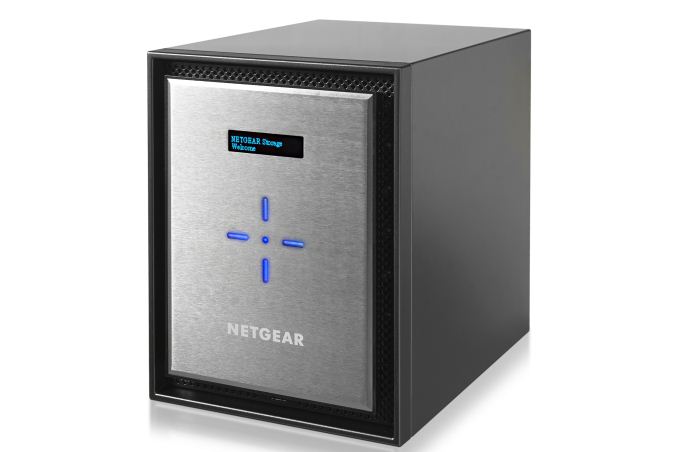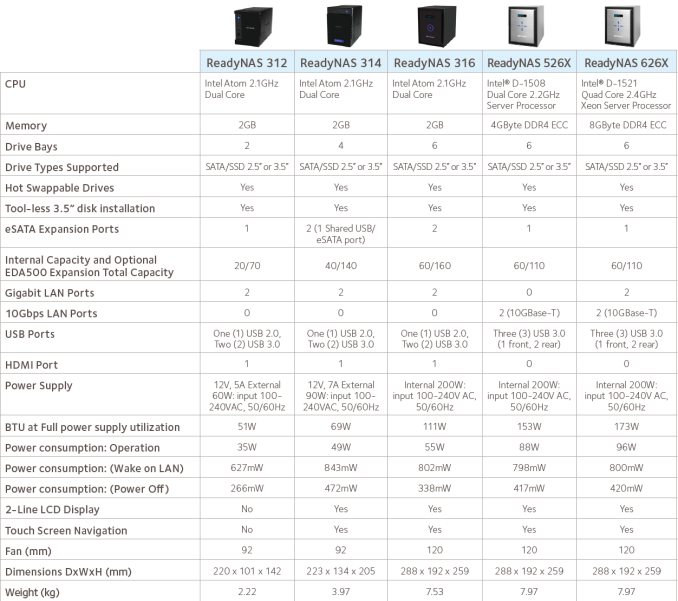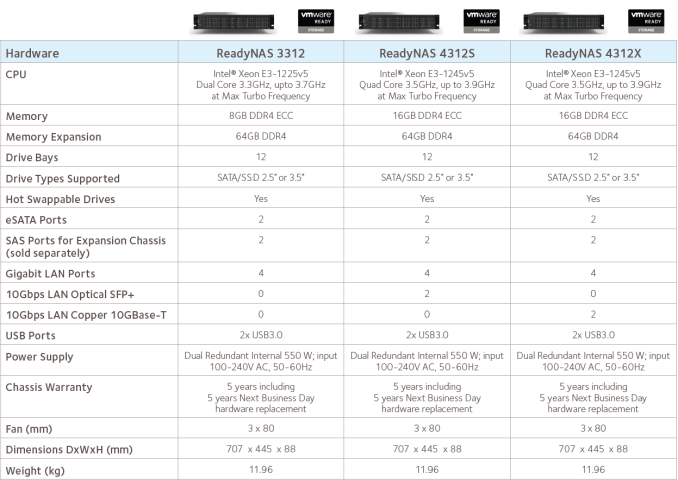Netgear Brings Broadwell-DE to COTS NAS Units with New 10G ReadyNAS Lineup
by Ganesh T S on September 1, 2016 8:30 AM EST
Netgear's ReadyNAS lineup was updated towards the end of last year with some units based on the Annapurna Labs ARM-based SoCs. This year, Netgear is targeting SMBs, creative professionals and SMEs with a new set of desktop and rackmount units based on high-end Intel SoCs and CPUs. All of the new units run ReadyNAS OS 6 - the first COTS (commercial off-the-shelf) NAS operating system to come with support for the btrfs file system.
At IFA 2016, Netgear is launching two new desktop models and two new rackmounts. All of the models, except for one of the rackmounts, come with native 10G capabilities. This goes well with the host of affordable 10G switches that Netgear has launched over the last couple of years. The desktop models are the most interesting from a platform viewpoint - the ReadyNAS 526X uses the Intel Pentium D-1508 2C/4T processor that comes under the Xeon-D 1500 lineup, and the ReadyNAS 626X uses the Intel Xeon D-1521 4C/8T processor. To our knowledge, these are the first COTS NAS units to use these Broadwell-DE (Xeon-D 1500) SoCs. The two units join the ReadyNAS 300 series units as part of Netgear's x86 ReadyNAS lineup. The important specifications of the two new units and how they compare with the other x86 units are provided below.
On the rackmount side, Netgear has opted for the Skylake Xeons. The new units have 12 bays and come with quad 1G LAN ports. All of them have two mini-SAS ports for storage expansion. The ReadyNAS 3312 doesn't have any 10G ports, while the ReadyNAS 4312 has two. The 4312S has two optical SFP+ 10G interfaces, while the 4312X has two 10GBase-T ports.
The only disappointing aspect is that the rackmount units don't come with support for SAS drives.
In terms of software features, the btrfs implementation allows Netgear to enable seamless snapshotting capabilities and also offer bitrot protection. There are some value additions in the form of ReadyDR (disaster recovery) that allows block-level backup to / restore from another ReadyNAS unit in the LAN. Netgear also has the ReadyCLOUD service for seamless VPN access and private cloud capabilities.
All the NAS models are available today. The diskless desktop versions come in at $1400 and $1800 for the RN526X and RN626X respectively. The diskless rackmounts are priced at $3000 (RN3312), $4200 (RN4312S) and $4400 (RN4312X).
Netgear's decision to go with the Xeon-D SoC lineup has enabled them to create more efficient units (in terms of hardware) compared to the competition. The ReadyNAS OS 6 features are also in the process of getting tuned with customer feedback. Most important business requirements are already implemented, but competitors have a huge advantage, thanks to third-party apps. Features such as native virtualization (host OS capabilities) and containers (Docker) support enable the competitors' units to fully utilize all the available CPU cycles (once the core requirements related to file serving are met). The same can't be said of Netgear's current version of the ReadyNAS OS. However, for SMBs / SMEs with well-defined requirements / workloads, the new 10G-enabled ReadyNAS units definitely merit consideration, thanks to a combination of attractive pricing and possible reseller-dependent deals involving bundled 10G switches.












17 Comments
View All Comments
ganeshts - Thursday, September 1, 2016 - link
ReadyNAS has been having it in production systems from before that.I covered Synology's btrfs launch here : http://www.anandtech.com/show/9700/synology-launch... : October 2015 ; We first looked at Netgear's btrfs in our November 2013 review of the RN312 : http://www.anandtech.com/show/7500/netgear-readyna... ]
I stand by my assertion that Netgear's ReadyNAS OS 6 was the first COTS NAS OS to come with support for the btrfs file system.
mdgm - Thursday, September 1, 2016 - link
BTRFS is the default and only filesystem we use for the data volume on all our new ReadyNAS models from 2013 onwards. All our units with Intel CPUs use it for the root volume too.You can power down an older x86 OS6 unit and move the disks across (best to keep the order the same) to an empty one of these new ReadyNAS models and power the new unit on.
dulinor - Friday, September 2, 2016 - link
Which is cool but if you have good disks in a bad SPARC ReadyNAS you're SOL. Had to pay eBay extortion for a new chassis just to extract my data.2009-2016 was a pretty good run, honestly, but I would have expected the drives to go before the unit.
mdgm - Saturday, September 3, 2016 - link
dulinor there are several points that can be made on this:1. Hardware can and does fail at any time. 7 years is a pretty good run. Some have longer runs, some not as long.
2. If the PSU failed that would be replaceable (but if you use a standard PSU a change to the pin out would be needed). Some older NV+ units (probably older than yours) are covered by a Service Action as they had defective PSUs that were known to fail prematurely.
3. The RAM is also replaceable if that has failed.
4. If the hardware has failed and can't be repaired you don't need to buy a chassis off eBay. There are instructions available for using an ordinary x86 Linux machine to recover your data. If the chassis failed, but the disks, array and volume are fine this should be straightforward. We also have the option for you to purchase a new NAS e.g. RN526X and purchase some help from support: http://kb.netgear.com/app/answers/detail/a_id/2987...
5. A NAS is not some magic solution to avoid backups. Things like multiple disk failures, other hardware failure, accidental file deletion, fire, flood, theft etc. can happen. RAID is not a replacement for backing up your data. We provide several backup options, to use the NAS as a backup for another device, or to backup data primarily stored on the NAS some place else.
MotorStallion - Tuesday, September 13, 2016 - link
New to this NAS space....How does this device compare with Synology DS716+II?mdgm - Thursday, September 15, 2016 - link
How NAS units compare for one's needs does depend very much on what one intends to do with it.Well for starters the RN526X and RN626X have 6-bays as opposed to the two of that other NAS. We also have 10 GBASE-T ports.
We're using a powerful CPU, we have more RAM and the RAM we use in these two models is ECC.
BTRFS has been used by the ReadyNAS for a lot longer. I am biased but I do feel our support for this filesystem is one of our strengths. We're using the 4.1 LTS kernel (we usually update to a newer minor release of this kernel in a firmware update) with some additional patches backported. You can see which kernel is being used by a device by looking at the GPL code for it.
mandakh - Tuesday, September 19, 2017 - link
rn526x model support 16GB ECC registered memory?